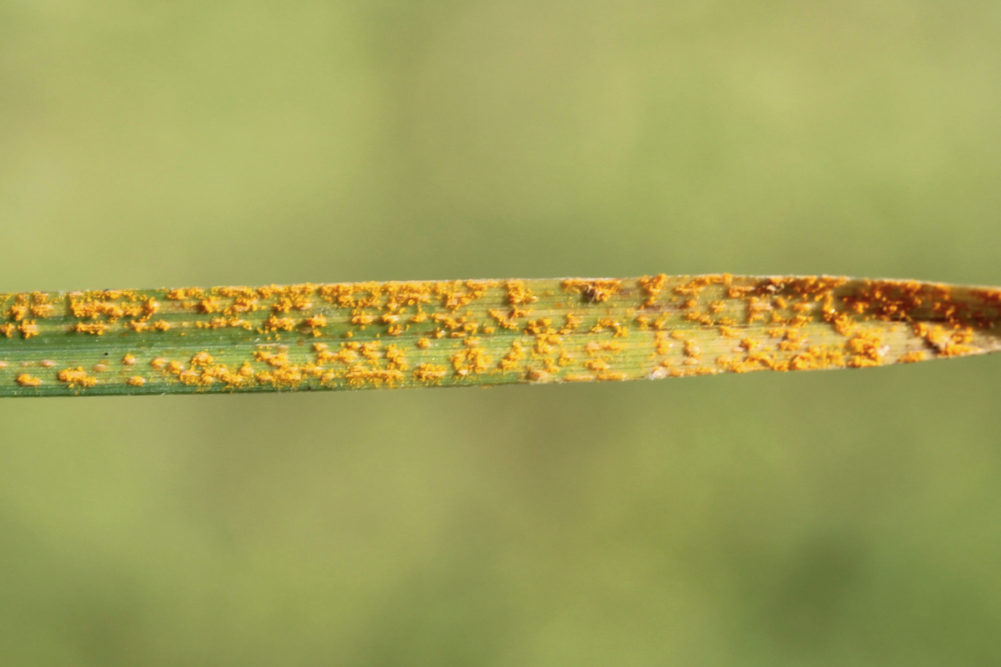MANHATTAN, KANSAS, US — A national team of US Department of Agriculture (USDA) scientists are being honored for their work in building sturdy resistance to a highly-virulent strain of stem rust in wheat.
The Borlaug Global Rust Initiative (BGRI) presented its 2020 Gene Stewardship award to a team of plant pathologists, geneticists, and agronomists at the USDA’s Agricultural Research Service (ARS) which include:
- Robert Bowden, supervisory research plant pathologist at USDA-ARS Hard Winter Wheat Genetics Research, adjunct faculty member at Kansas State University
- Harold E. Bockelman, supervisory agronomist at USDA-ARS Small Grains and Potato Germplasm Research
- Mike Bonman, supervisory research plant pathologist at USDA-ARS Small Grains and Potato Germplasm Research
- Tyler Gordon, plant pathologist at USDA-ARS Small Grains and Potato Germplasm Research
- Mary Guttieri, research geneticist at USDA-ARS Hard Winter Wheat Genetics Research, adjunct faculty member at Kansas State University
- Yue Jin, research plant pathologist at USDA-ARS Cereal Disease Laboratory
- David Marshall, research leader at USDA-ARS Plant Science Research
- Matthew Rouse, research plant pathologist at USDA-ARS Cereal Disease Laboratory
- Steven Xu, research geneticist at USDA-ARS Cereal Crops Research
“Combatting Ug99 and the other cereal rusts is definitely a team effort,” said Robert Bowden, supervisory research plant pathologist at USDA-ARS Hard Winter Wheat Genetics Research and adjunct faculty member at KSU. “We’re proud at the USDA to be part of the amazing and inspiring global effort to deploy durable resistance to protect our crops and communities from these ancient enemies.”
Bowden said the group’s success hinges on stacking genes resistant to Ug99, a stem rust that has wreaked havoc in parts of Africa since the late 1990s, and other parts of the world since then.
“Gene stewardship is taking care of genes so they will be useful in the future, in addition to their usefulness now,” Bowden said. “We’ve had a lot of resistance genes over the years and we tend to put them out one at a time. But the pathogen (stem rust) can actually mutate and defeat the resistance gene.”
Wheat scientists at KSU have been successful in locating molecular markers in resistance genes that allow them to stack the genes one on top of the other and form a pyramid that is more durable to stem rust’s attempts to beat the resistance.
“It’s very difficult to stack the genes,” Bowden said. “But when you are able to stack them, they protect each other. The probability of defeating one gene is a certain number — let’s say one in a million. So then, the probability of defeating two genes is one in a million times one in a million.
“When you stack them up, it becomes less and less probable that the pathogen is going to be able to mutate and defeat all of the genes in this deck. So, if you want a gene to last a long time, you put it in a stack. Even if the pathogen defeats one, it doesn’t defeat the rest.”
Bowden and Guttieri have worked to stack six genes resistant to stem rust.
Currently, Ug99 and other stem rusts are not a problem in Kansas or the United States. US farmers are probably more aware or concerned with leader rust and stripe rust. The team also is working to combat both of those rust diseases by building pyramids of resistance.
“We’re proud to be part of the larger KSU team and the bigger USDA team and even the much bigger global team that is doing this work,” Bowden said. “Everybody is working together wonderfully, and it’s inspiring.”






